

NSW koala bill dumped after Liberal MP Catherine Cusack crosses floor - ABC News. Tensions within NSW's Coalition Government over koala policy has boiled over, with a Liberal MP crossing the floor to vote down a land bill.
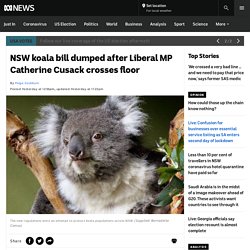
Liberal MP Catherine Cusack made an emotional speech to Parliament before crossing the floorHer vote meant the bill was defeated 18-19She said the bill was about patching up a political disagreement, not protecting koalas Upper House MP Catherine Cusack's move rankled Premier Gladys Berejiklian, who sacked her from her role as a parliamentary secretary shortly after yesterday afternoon's vote.
It is not the first flashpoint with the NSW Government over the proposed changes to planning rules designed to protect koala habitats. A previously private Coalition policy difference exploded into a public debate on September 10, when Deputy Premier John Barilaro, who is the Nationals leader, threatened to move his MPs to the crossbench over the policy. Ms Cusack's vote was the decider, leaving the Liberals, Nationals, Fred Nile and One Nation one short, 18-19.
Numbat numbers at WA's Dryandra Woodland grow as feral cat culling program kicks in - ABC News. Numbat numbers at a conservation site in Western Australia’s Wheatbelt are the highest recorded in decades, as feral cat eradication continues.
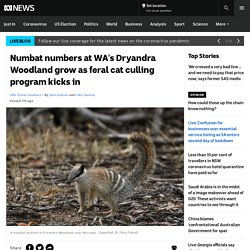
Key points: Endangered numbat numbers are on the rise in Dryandra WoodlandThe marsupial is only found in the wild in parts of Western AustraliaThe populations of other native animals are also growing following a program to cut feral cat numbers Scientists completing an annual numbat count at Dryandra Woodland were thrilled to record 35 numbats — the most since a survey in the 1990s recorded 36. The figure was up from 10 last year and just five in 2018. Endangered Kroombit tinker frog bred in captivity for first time after 20 years of trying - ABC News. After two decades of trial and error, a team of scientists has finally bred the Kroombit tinker frog in captivity in the hopes of preventing its extinction.
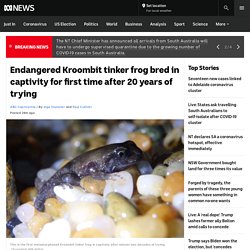
Key points: The Kroombit tinker frog is critically endangered and found in just a few patches of rainforest at Kroombit Tops National Park in central QueenslandA team of scientists has bred a froglet at the Currumbin Wildlife Sanctuary on the Gold Coast after years of trial and errorThe breeding program is described as an exciting development The frog is thought to number 200 at best and is found only in small patches of rainforest at Kroombit Tops National Park, a plateau about 70 kilometres south-west of Gladstone in central Queensland. Ed Meyer, from the Queensland Frog Society, says the breeding plan was first hatched in the early 2000s when he and others became aware of the frog's decline.
It was then another 12 years of trial and error before this hatchling. Volunteers rejuvenating culturally significant Aldinga Washpool Lagoon now want it protected - ABC News. A community south of Adelaide is fighting to protect an environmentally and culturally significant wetland from urban growth.
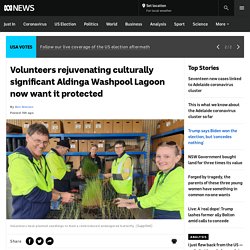
Key points: The Aldinga Washpool Lagoon is a culturally significant area for the Kaurna people The area is home to about 250 species of flora and fauna The government is working to protect the area from urban growth The Aldinga Washpool Lagoon is one of the last wetlands of its type along the metropolitan coastline and is home to about 250 species of flora and fauna. It has been the focus of a major re-wilding project, including the reintroduction of plants and wildlife once lost from the area. "It's an incredibly valuable locality for both us and nature, it's an area that has great opportunity for the conservation of species," University of South Australia biology professor Chris Daniels said. Volunteers have helped plant seedlings of gahnia, upon which the yellowish sedge skipper butterfly lives.
Purple swamphen and eastern long-necked turtle re-emerge in parts of Shoalhaven - ABC News. A unique bird is making a comeback on the New South Wales south coast after being elusive in parts of the region for almost 40 years.
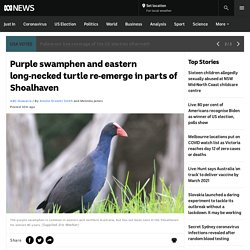
Key points: Purple swamphens and eastern long-necked turtles have re-emerged on a Cambewarra propertyResident Peter Jirgens says he has not seen either of the species on his land for decadesHe puts it down to a successful local fox baiting program that has seen more than 200 of the pests culled The flightless, ground-dwelling purple swamphen is distinctive because of its bright and unusual plumage coupled with its red oversized bill and frontal shield. "Three of them just walked into our backyard the other day," Cambewarra resident Peter Jirgens said.
Brolgas and sarus cranes create hybrid species in Queensland’s Gulf Country - ABC News. An "evolutionary dance" is taking place in the Gulf Country of northern Queensland as two similar, but separate, species of bird are crossbreeding to produce a new hybrid species.

Key points: Scientists have discovered a new hybrid species of bird created by brolgas and sarus cranes crossbreeding The brolga and sarus crane share many similarities but also have some distinct genetic differencesScientists are unsure why the two birds are crossbreeding and if it will eventually result in one or more species The brolga and sarus crane share many similarities — both are species of crane and at a quick glance they look almost identical. But there are some distinct genetic differences, including the larger sarus crane's pink legs and its lack of dewlap, a fold of loose skin hanging from the neck. Endangered ospreys tagged with satellite trackers in Australia-first research into declining population - ABC News. Solar-powered satellite trackers have been fixed to endangered ospreys for the first time in Australia, with the hope they will uncover many unanswered questions about the fish-hunting hawk's declining population.
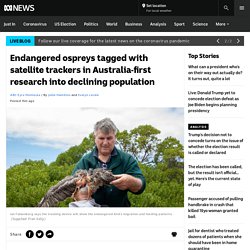
Key points: The solar-powered satellites sit on a harness attached to the bird’s backOne nest in Port Lincoln and the another in Thistle Island have been chosen for the projectBirdlife Raptor's Ian Falkenberg says one of the bird is in a populated area and the other in a remote island Birdlife Raptor' Ian Falkenberg was tasked with the job of placing a harness to fix the satellite on two chicks at Port Lincoln and Thistle Island. He said the trackers could give specific information on the fall in the bird's population.
"This is really the best way to find out what the birds are doing during their day-to-day life and where they're going. " Citizen interest. Norfolk Island snail believed extinct since the 1990s rediscovered, boosting hopes - ABC News. A second species of snail assumed extinct has been rediscovered on remote Norfolk Island, 1,700 kilometres east of Sydney.
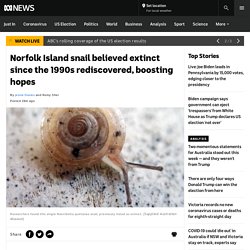
Key points: The snail Nancibella quintalia was listed as extinct in the mid-1990sAn Australian Museum team returned to the island after rediscovering another species also listed as extinct, Advena campbelli, in MarchThe hope to establish an insurance population for Norfolk Island's rare land snails at Sydney's Taronga Zoo This month, researchers from the Australian Museum found a single living specimen of the land snail Nancibella quintalia, listed as extinct in the mid-1990s. The museum's snail expert Dr Isabel Hyman said the find was "extremely exciting". Jaguar parts smuggled from Latin America to China via secret routes, environmental report says - ABC News.
Criminal organisations in Bolivia and other Latin American countries are bribing police and circumventing customs restrictions to smuggle parts of jaguars to mainland China, according to an investigation by environmental groups.
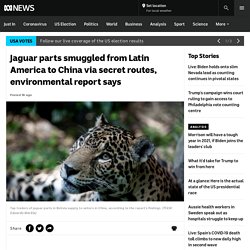
Key points: Jaguars, Latin America's biggest cat, are classified as near-threatenedThere has been a huge demand for exotic animals in China in recent timesCriminal groups in Bolivia take advantage of inadequate law enforcement, the report found Seventy-five intelligence sources across Latin America, including traffickers, confirmed in a report commissioned by the International Union for Conservation of Nature in the Netherlands (IUCN NL) that criminals operate established routes and sometimes bribe high-ranking police officers to look the other way. Newborn eastern quoll joeys to be tracked with tail transmitters - ABC News. For the first time tracking devices are set to be placed on the tails of eastern quoll joeys on the New South Wales South Coast.
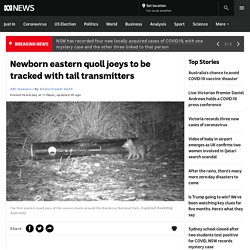
Key points: Two eastern quoll joeys have been spotted in a New South Wales national parkThe quolls, which went extinct on the mainland 50 years ago, were recently reintroduced to Booderee National ParkRewilding Australia will use tail transmitters to track their progress Rewilding Australia has been reintroducing the species to the Booderee National Park in a bid to reverse their extinction on mainland Australia. This week the first two joeys of the season were spotted on a wildlife camera in the park, and transmitters will soon be used to monitor their progress.
Tasmania has no wild koalas — but could play a role in the survival of the species - ABC News. Three Hummock Island sits 30 kilometres off the north-west coast of Tasmania, in the wild waters of Bass Strait. The 70-square-kilometre granite island has stunning deserted beaches, a rich Aboriginal history and abundant wildlife. There is just a smattering of buildings and caretakers are the only residents, but the island was once home to a handful of imported koalas.
Four adult koalas were released into the wild on Three Hummock Island in 1947 by the family that was leasing it at the time. Cissie and Bill Nichols ran the island as a farm from 1932 to 1951, when Eleanor Alliston and her husband took over for what became the longest period of European occupation. Federal Environment Minister approves koala habitat clearing for Brandy Hill quarry expansion - ABC News. The expansion of a controversial rock quarry that will clear 52 hectares of koala habitat north of Newcastle has been approved by the Federal Environment Minister Sussan Ley. Key points: The expansion will allow the quarry to double its production to supply the Sydney construction marketEcologists say the expansion will sever a vital habitat corridor for breeding koala coloniesLocal residents say they are shocked and devastated by the decision The minister had been under significant community pressure to step in and stop the Brandy Hill project in Port Stephens, after it was approved by the New South Wales Government in July.
The grassroots campaign attracted support from celebrities such as Olivia Newton-John, Celeste Barber, Jimmy Barnes and Magda Szubanski. The NSW Environment Minister Matt Kean had even backed away from his own government's decision, calling on Ms Ley to closely review the project. Locals 'shocked and upset' DPIPWE gave salmon farm giant Tassal green light to trap seals - ABC News. Newly released documents reveal a Tasmanian government department gave aquaculture giant Tassal a permit to keep up to 20 trapped seals in empty salmon pens, at the same time as the department was investigating allegations the company broke the law by doing exactly that.
Key points: The department began investigating allegations Tassal kept 20 seals in an empty salmon pen in September 2016In October 2016 the department granted Tassal a permit to keep up to 20 seals in empty salmon pensNew documents reveal departmental employees consulted with Tassal about responding to media questions about the investigation The documents also show department staff discussed with Tassal how they would answer questions from the media about the investigation.
They document an investigation by the Department of Primary Industries, Parks, Water and Environment (DPIPWE) into allegations Tassal workers kept up to 20 Australian fur seals in an empty salmon pen without food for multiple days. Key points: Anti-fracking protesters who drilled into NT Parliament House lawns plead not guilty to criminal damage - ABC News. Two anti-fracking protesters have pleaded not guilty to criminal charges after using a bobcat to dig holes in the grass outside Northern Territory Parliament House last year. The pair was charged with criminal damage to property after the 2019 incidentOne of the defendants said they were protesting a decision to allow fracking in the NTAn application for a new judge to hear the case was denied Lauren Mellor and Conrad Rory, who are charged with one count each of criminal damage to property, were part of environmental group Protect Country Alliance when they organised the 2019 protest action.
Mr Rory, who is a Traditional Owner, drove the bobcat to protest against the NT Government's decision to lift its moratorium on fracking. He was accompanied by other traditional owners and family members from the region surrounding Borroloola, where exploration permits for fracking have been granted and test wells drilled. Natural History Museum's Wildlife Photographer of the Year contest won by Sergey Gorshkov with photo of Siberian tiger - ABC News. It took wildlife photographer Sergey Gorshkov 11 months to capture the fleeting moment in the Russian Far East. Key points: Sergey Gorshkov's image of the tiger sees him named Wildlife Photographer of the YearThe image was selected ahead of 49,000 other entries from around the worldIt is among the winners of several categories announced at London's Natural History Museum A Siberian, or Amur, tigress hugging an ancient Manchurian fir tree.
It's palolo season in Samoa and locals have just a few nights to hunt for this ocean delicacy - ABC News. To the untrained eye they look like worms, but Samoans know these marine creatures as palolo, and they are revered as the caviar of the South Pacific. They are found in shallow coral reefs, are often electric blue in colour, and Samoans only have a small window to ka palolo (catch palolo), because they only appear for a few days every year. Makeshift research fleet undertakes first Great Barrier Reef 'census' citizen science project - ABC News. Sydney news: Fire destroys properties at Bar Point, koala policy changes considered - ABC News. Native Glenelg freshwater mussels return to the river after being evacuated during bushfires - ABC News. Queensland government approval of Olive Downs Coking Coal Project criticised by conservation groups - ABC News.
Conservation groups say they're disappointed the Queensland Government has approved the state's third-largest coal mine, because of the threat it poses to koala habitats. Key points: Queensland scientists track green turtles from space in bid to conserve vulnerable species - ABC News. A method called "turtle rodeo" is being used to track vulnerable green turtles from space and study how they live in a bustling Queensland port. Key points: Australia singled out for mammal extinction in UN's dire global biodiversity report - ABC News. Feral cats threatening endangered species on Kangaroo Island after bushfires - ABC News. Indigenous expert cat tracking 'very efficient' in supporting threatened bilby species, research finds - ABC News. Abrolhos Island seabirds at greater risk than ever before, says long-time scientist - ABC News.
WWF report finds 71pc decline in koala numbers across northern NSW bushfire-affected areas - ABC News. Australia Remastered restores ABC Natural History Unit films, not seen for decades, to share with a new audience - ABC News. NSW Government puts Sydney developer Lendlease on notice after unveiling koala conservation plan - ABC News. Released captive-bred regent honeyeater leads conservationists to wild Hunter Valley flock - ABC News. Hunter galaxias fish species at threat of extinction due to 'alien' trout, weather - ABC News. Threatened Carnaby's Black-Cockatoo receive federal funding to help the Western Australian bird soar - ABC News.
Northern white rhino eggs harvested from final two animals in bid to prevent extinction - ABC News. Most orange-bellied parrots don't survive their first migration — and Tasmanian researchers want to know why - ABC News. How a Lombok fisherman and a shark lover became unlikely allies. Eastern hooded plover numbers on the rise thanks to volunteers, fewer visitors - ABC News. Echidna breeding season underway, with rare group sightings by bushwalkers more likely - ABC News.
Plan to build in critical koala habitat sparks local anger as developer challenges council rejection - ABC News. Walkers shocked to find native kingfishers with their feet glued to Cathu State Forest welcome sign - ABC News. The woman on a mission to save Tasmania's giant freshwater crayfish - ABC News. Glossy black-cockatoo sightings inland suggest tough times for rare Australian bird species - ABC News.
The mystery of the mouse that died of smoke inhalation, but went nowhere near a fire - ABC News. Critically endangered swift parrot released after surviving 600km journey to Lord Howe Island - ABC News. Platypus extinction looms unless urgent action is taken, UNSW study finds. Posted about 5 hours agoMon 20 Jan 2020, 7:20am Australia's iconic platypus is on the brink of extinction, according to a new study by the University of New South Wales. Key points: The platypus is not officially listed as a threatened species, but new research suggest the animal may be in dire troubleA conservation group says platypuses in north-east NSW seem to have disappeared due to the drought and the impact of feral pests and livestockThe authors of the UNSW study say climate change is also a factor, and that urgent action is needed to save the platypus Platypuses have been found dead in dried up creeks in NSW due to drought and human activity such as damming and water harvesting, threats from feral species in national parks, and the impacts of livestock.
The lead author of the UNSW study, Gilad Bino, said action must be taken now to prevent the platypus from disappearing from our waterways. Orange roughy fishery report recommends 'sustainable seafood' status — but is slammed by conservation groups - ABC News. Orca populations may extend beyond Bremer Bay hotspot, researchers say - ABC News. NSW buys outback station in state's largest single property purchase for a national park - ABC News. Rising sea levels threaten critically endangered Capricorn yellow chat - ABC News. Four men arrested over the killing of endangered mountain gorilla Rafiki in Uganda - ABC News. Tiger poachers have emerged as unlikely conservationists in an Indian village - ABC News. Green turtle rookery on Raine Island brought back from brink, but scientists' fight not over yet - ABC News. New aerial biocontrol weapon released to help fight notorious tropical Siam weed - ABC News.
Murray River's Lower Lakes review finds Ramsar-listed area is a freshwater ecosystem - ABC News. In the middle of coronavirus, two botanists went on a race against time to witness Tasmania's pencil pines seed - ABC News. Wedge-tailed eagle deaths prompt review of Victorian Wildlife Act - ABC News. Butterflies crucial to outback pollination, despite being 'more interested in sex' - ABC News. False Bay's great white sharks have vanished, and the answer may be in our fish and chips - ABC News.
Virus causing lorikeets to 'drop out of the sky' resurfaces in South-East Queensland - ABC News. Australian scientist names tiny Antarctic creature after climate activist Greta Thunberg. Updated about 7 hours agoFri 24 Apr 2020, 8:46am An Australian scientist has named a tiny six-legged creature that lives in a harsh Antarctic environment after Swedish climate change activist Greta Thunberg. Key points: An Australian scientist has identified a new species of a tiny creature called a springtailThe insect-like creatures are found throughout the world, but are inconspicuous because of their sizePenelope Greenslade has named her discovery Frisea gretae in honour of teen climate activist Greta Thunberg The creature, known as a springtail, was identified by Penelope Greenslade, an honorary research fellow at Federation University.
Dr Greenslade said naming the species after Ms Thunberg seemed apt, given where it lived. "Climate change is particularly evident in the Antarctic because you can actually measure glaciers melting," she said. Ecologist warns of dingo 'functional extinction' north of dog fence ahead of new controls.
Posted about 3 hours agoFri 24 Apr 2020, 1:53am. Global 'insect apocalypse' severity called into question by new research - Science - ABC News. Australia's threatened mammals decline by more than a third since 1990s, but there's a silver lining - Science - ABC News. Sea eagle released into wild after being found covered in fish oil and close to death. Breakthrough for Norfolk Island's morepork owl, one of the world's rarest species. Tasmanian tiger quest catches eye of Vice documentary makers.
Yoda the green sea turtle released, months after washing up on remote Queensland beach. Desert frogs resurface after months — and sometimes years — underground waiting for rain - ABC Rural - ABC News. Six species of native Australian gecko identified in long-running research project. Christmas Island robber crab suspected of nicking expensive camera in late-night burglary. Echidnas, koalas, kangaroos and other wildlife find a new home after devastating SA bushfires. WA Government puts a 12-month halt on logging of mature karri forests in the South West. Koala losses from recent NSW bushfires 'One of the most significant biodiversity impacts in our history' Two green turtles rescued on NSW coastline as warmer waters push population south.
Native frogs are being confused for cane toads in fatal case of mistaken identity. Loggerhead turtle's journey tracked 37,000km from Cape Town in South Africa to Australia. The New Zealand kea can understand probability, a cognitive trait only seen before in apes and humans - Science News - ABC News. Rare bristlebirds rescued in Chinook helicopter mercy dash during East Gippsland bushfires. Orphaned echidna getting a second chance at life at Alice Springs Desert Park.
Pink manta ray named Inspector Clouseau could be unique to Great Barrier Reef. Tasmania Parks and Wildlife Service asks track users to think twice before picking up a walking stick. Alice Springs residents want action over perceived 'crime wave', but police say stats are down. Ten thousand koalas may have died in NSW bushfires, inquiry hears.
Greater glider habitat illegally cleared by grazier, department finds. Gould's petrels found breeding for the first time in a decade hailed a success for Broughton Island project. Think Australia's bushfires killed a lot of animals? Weak environmental laws threaten the lives of more - Science News - ABC News. Tropical snake decline linked to deadly frog disease - Science News - ABC News. Bushfires leave 113 Australian native species in need of urgent help, report finds. Native fish rescued after bushfires, rainfall and predators threaten their survival. Rain helps save endangered Manning River turtle, but experts say many threats remain. Wombat water hole proving popular in drought-ravaged Hunter Valley. Mount Lofty Defence housing plan ignites debate on loss of koala habit to development.
NSW Premier Gladys Berejiklian urged to call for logging moratorium to save koalas in leaked letter. Spanner crab populations saved from the brink of collapse, but fishers' plea to continue protections - ABC Rural - ABC News. Koala deaths in Victorian blue gum plantation 'a crime', Environment Minister Lily D'Ambrosio says. On World Wetlands Day, learn more about 'the kidneys' of the environment. Have more than a billion animals perished nationwide this bushfire season? Here are the facts - Fact Check. Victorian Supreme Court orders temporary halt to logging due to impact of Gippsland bushfires. Threatened ghost bats a 'main issue' for Northern Territory gold mine's green light. Park rangers feared the iconic neon pink Mount Kaputar slugs were wiped out by bushfires — then it rained. Koala Conservation Strategy consultation closing as ecologist calls for 'bold' solution to extinction.
Post-bushfire logging makes a bad situation even worse, but the industry is ignoring the science.